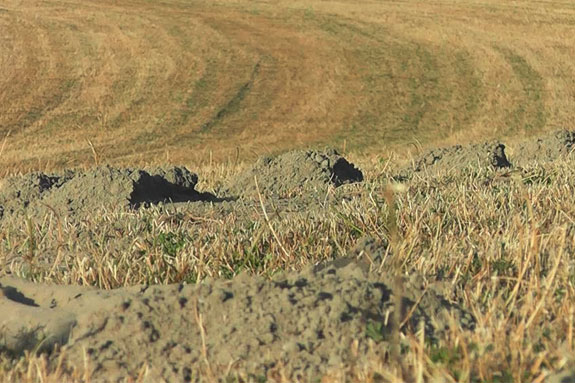However, less-frequent tilling has led to rising pocket gopher populations and burrowing activity, which can reduce the productivity of alfalfa fields by 20 to 50 percent.
During the last 53 years, pest-control adviser Vernon Crawford has been known for finding ways to help solve problems that plague San Joaquin Valley growers.
Recently, he’s been putting more emphasis on pocket gopher control in alfalfa fields, an increasing problem that’s costing more money and needs better control options.
Crawford began farming in 1960, and in 1972, he joined the Wilbur-Ellis branch in Shafter, Kern County, California.
Gophers have caused trouble wherever he’s worked, said Crawford, and he wants to stress the importance of protecting both biotech and non-biotech alfalfa.
“Alfalfa, with its thick, deep roots is one of gophers’ favorites – particularly in irrigated fields that have transitioned from flood to pivot or drip systems,” notes Crawford.
In one instance, when a grower rotated out an 88-acre alfalfa field after only three years, over 500 gophers were killed in one day. Crawford attributes this enormous gopher population to decreased tractor activity and lack of monitoring.
Better results
To do a better job of controlling pocket gophers Crawford is currently working to put more emphasis on baiting with a burrow builder, which is being used more in the Western states.
With this system, a tractor pulls a burrow builder with a three-point hitch creating artificial burrows. Bait is dropped into these burrows at set intervals.
While burrow builders have been around for many years, the older models often did not hold up to heavy use and often caused damage to the alfalfa plant.
However, advancements in burrow builder technology have eliminated these negative impacts to the plant while improving run speed and effectiveness.
Crawford depends on burrow builders to get quicker results on large fields rather than trapping or using other labor-intensive tactics like exploders or gassing devices.

Crawford also says it’s important to treat fields more than once a year since gophers can reproduce up to three times a year. In non-irrigated alfalfa, late fall or early spring is a good time to control gophers – when soil conditions are often moist and gophers are usually at a lower number.
Gopher problems in irrigated fields should get more immediate treatments after cuttings in summer or fall.
A paper by Dr. Roger A. Baldwin, University of California wildlife pest-management adviser, noted if a gopher population is reduced by only 60 percent and the field is not treated again until the following year, surviving gophers will have had time to breed and repopulate the area to approximately the same level they achieved the year before.
How much money is lost to gophers each year? A recent study by Baldwin estimated “an 8.8 percent loss in revenue” when pocket gophers are present.
Damage can occur in a number of ways, ranging from gophers eating taproots and above-ground vegetation, to loss of hay quality, to slope damage and losing “irrigation water down burrow systems.”
Other problems Baldwin noted include, “spread of weed seed, burying of plants and damage to farm equipment.”
It can cost up to $500 per acre to establish a stand of Round-up Ready alfalfa. That stand should last at least five years.
Don’t let the benefits of Round-up Ready alfalfa become offset by uncontrolled populations of pocket gophers. Continuous monitoring and management of gopher populations is crucial to alfalfa longevity and profits. FG
References omitted due to space but are available upon request. Click here to email an editor.

Ted Bruesch
Technical Services Mgr.
Liphatech Inc.
Aaron Kiess
Executive Director 2000-2013 (retired)
California Alfalfa & Forage Association








